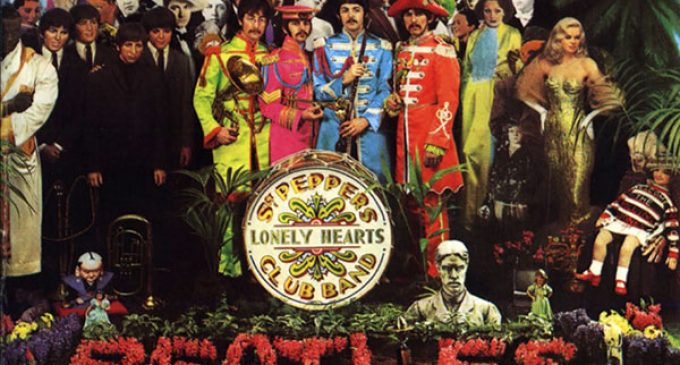50 Fun Facts About The Beatles’ “Sgt Pepper’s Lonely Hearts Club Band”

Yep, The Beatles Sgt Pepper’s Lonely Hearts Club Band is reissued on May 26, a whole 50 years after it was first released. But while you and your pals inevitably argue about the merits of The Beatles’ eighth album, why not, erm, “pepper” the conversation with these 50 fun facts – intriguing, amazing, baffling and – sometimes – downright useless! What else are we going to do? Review it? There’s no point; you probably already know all the songs. But what you may not know is… The concept of an alter-ego band was Paul McCartney’s idea. In John Lennon’s words (1980): “Sgt Pepper is Paul, after a trip to America and the whole Western Coast, long-named group thing was coming in. You know, when people were no longer The Beatles or The Crickets – they were suddenly Fred and His Incredible Shrinking Grateful Airplanes, right? So I think he got influenced by that and came up with this idea for The Beatles.” McCartney says he decided on the idea while on a flight back to London from Kenya in November 1966. He decided he wanted to write a song about a military band in the Edwardian era. The Beatles played Canada in ‘64, ‘65 and 1966: a police officer assigned to their entourage in Toronto one of those years was one Sergeant Randy Pepper. Apparently. It’s definitely true, though, that McCartney’s jacket has an O.P.P. (Ontario Provincial Police) patch on its left arm. Work began on the LP in Autumn 1966. The album was finally released on June 1, 1967. Sgt Pepper was the first album ever to be released simultaneously around the world. It was also the first Beatles album to have the same track-listing for both the U.K. and US versions. It varied in other territories (particularly the Far East), as some songs were banned. Sgt. Pepper’s Lonely Hearts Club Band was recorded using four-track equipment at Abbey Road Studios, London. The Beatles and George Martin agreed that they wouldn’t repeat techniques used on Revolver: no vocals through Leslie rotary cabinets, no “Tomorrow Never Knows”–style tape loops and no backward vocals or guitars. “On Pepper, it was like starting over from scratch, getting down to the individual tonalities of the instruments and changing them,” explained engineer Geoff Emerick. “They didn’t want a guitar to sound like a guitar anymore. They didn’t want anything to sound like what it was.” They also used a different room. Emerick explained: “Revolverwas done in Number Three studio, which is a smaller room. It was a dirtier-sounding studio acoustically.” Sgt Pepper was recorded in Number Two, a larger room. “Number Two is a brighter studio, and you can get cleaner tones.” Of the Beatles’ Gibson/Epiphone guitars used heavily, Lennon and Harrison played their Epiphone Casinos and Gibson J-160E acoustics; Harrison also played his Gibson SG. For his 6-string guitar parts McCartney’s used his own Epiphone Casino. The first songs to be recorded were “When I’m Sixty-Four”, “Strawberry Fields Forever” and “Penny Lane”. Famously, “Penny Lane” and “Strawberry Fields Forever”, were taken for the group’s first single of 1967 (a double A-side) after a demand for a new release from Parlophone/EMI. George Martin later described the decision to remove the two Liverpool-centric songs from the album as “a dreadful mistake”. The double A-side single even failed to reach the number one spot in the U.K. So, as it was to be released, the album’s monumental closer, “A Day In The Life”, was recorded from January 1967; the second song from the album Sgt Pepper song to be taped. The third was the title track, which was first recorded on February 1 1967. The stereo mixing was done incredibly quickly. Engineer Geoff Emerick recalled, “We spent three weeks on the mono mixes and maybe three days on the stereo.” On previous albums, Paul McCartney always laid down his bass parts with the rest of the group, but on Sgt. Pepper, Emerick gave him his own track, onto which he would record his bass parts. They were later “bounced” onto other band tracks. On the title track, McCartney’s bass was recorded by DI (direct injection) into the mixing desk. It was the first time The Beatles had used this technique. “Jesus” was a studio guest for the recording of “Fixing a Hole.” In the book Many Years From Now (by Barry Miles), Paul McCartney explained: “A guy arrived at my front gate and I said ‘Yes? Hello’ because I always used to answer it to everyone. If they were boring I would say, ‘Sorry, no,’ and they generally went away. This guy said, ‘I’m Jesus Christ.’ I said, ‘Oop,’ slightly shocked. I said, ‘Well, you’d better come in then.’ I thought, Well, it probably isn’t. But if he is, I’m not going to be the one to turn him away. So I gave him a cup of tea and we just chatted and I asked, ‘Why do you think you are Jesus?’ There were a lot of casualties about then. “We used to get a lot of people who were maybe insecure o
Source: 50 Fun Facts About The Beatles’ “Sgt Pepper’s Lonely Hearts Club Band”




There are no comments at the moment, do you want to add one?
Write a comment